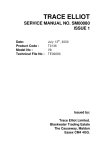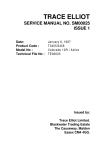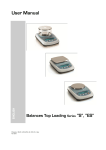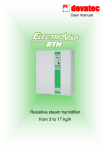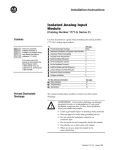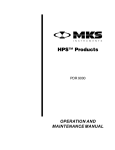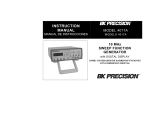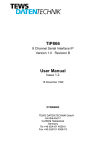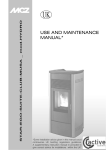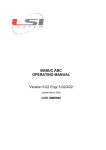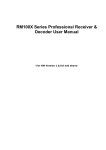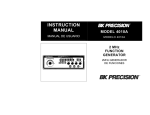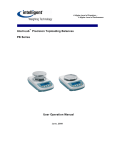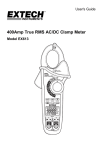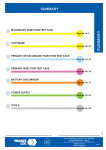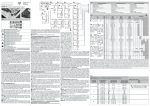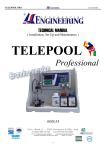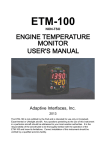Download CH SERIES - CoffeeSnobs
Transcript
USER’S MANUAL PROCESS CONTROLLER CH SERIES ManCH-UK Vers 1.3 May’09 ITALCOPPIE SENSORI s.r.l. CH SERIES PROCESS CONTROLLER WARNING • If failure or error of this instrument could result in a critical accident of the system, install an external protection circuit to prevent such an accident • Do not turn on the power supply untill all of the wiring is completed. Otherwise electric shock, fire or malfunction may result. • Use this instrument within the scope of specifications. Otherwise fire or malfunction my result. • Do not use this instrument in the place subject to flammable or explosive gas. • Do not touch high-voltage blocks such as power supply terminals, etc. otherwise electric shock my result. • Never disassemble, repair or modify the instrument. This may cause electric shock, fire or malfunction. • Over-temperature protection: Any control system design should take into account that any part of the system has the potential to fail. For temperature control systems, continued heating should be considered the most dangerous condition, and the machine should be designed to automatically stop heating if unregulated due to the failure of the control unit or for any other reason. The following are the most likely causes of unwanted continued heating: o Controller failure with heating output coinstantly on o Disengagement of the temperature sensor from the system o A short circuit in the thermocouple wiring o A valve or switch contact point outside the system is locked to keep the heat switched on. In any application where physical injury or destruction of equipment might occur, we recommend the installation of independent safety equipment, with a separate temperature sensor, to disable the hetaing circuit in case of overheating. The control alarm signal is not designed to function as a protective measure in case of controller failure. • This is a Class A instrument. In a domestic environment this instrument may cause radio interference, in wich case the user is required to take adequate measures. • This instrument is protected from electric shock by reinforced insulation. So please arrange reinforced insulation to the wire for input signals against the wire for instrument power supply, source of power and load as far as possible. CAUTION Pag. 2 ITALCOPPIE SENSORI s.r.l. CH SERIES PROCESS CONTROLLER • This instrument is manifacured on the assumption that it is used in the condition of being mounted on the instrumentation panel. Therefore, take the necessary measures on the equipement side mounted with this instrument so that the operator personnel are not accessible to high-voltage blocks in this instrument such as power supply terminals. • Always observe precautions described in this manual. Otherwise serious injury or accident may result. • Conduct all of the wiring in accordance with the local codes and regulations. • Install a protection device as fuse, etc. in the power supply, input or output line if necessary. • Do not allow metal fragments or lead wire scraps to fall inside this instrument. This may cause electric shock, fire or malfunction. • Firmly tighten each terminal screw at the specified torque. Otherwise electric shock or fire my result. • Do not place any obstacle around this instrument in order not to impede radiation of heat. And do not close ventilation holes. • Do not connect wires to unused terminals. • Please apply appropiate power source to instrument according to rated power show on label over instrument: a wrong power supply could damage the instrument and my cause short circuit or burn out. • Before cleaning the instrument, always turn off the power supply. • Remove stains from this instrument using a soft, dry cloth. Do not use a volatile solvent such as thinner in order to avoid deformation or decoloration. • Do not rub not strike the display unit of this instrument with a hard object. This controller has been designed with compliance to ‘Regulations on electrical apparatus (appliance, systems and installations) according to the European Community directive 73/23/EEC amended by the European Comunity directive 93/68/EEC and the Regulations on the essential protection requirements in electrical apparatus EN61010- 1 : 93 + A2:95. It is important to understand that it’s responsibility of the installer to ensure the compliance of the regulations on safety requirements and EMC. The products meet the requirements for the European WEEE. Note:Information in this user’s manual is subject to change without notice. No part of this pubblication my be reproduced, transmitted, transcribed or stored in a retrieval system, or translated into any language in any form by any means without the written permission of the Italcoppie sensori s.r.l. Pag. 3 ITALCOPPIE SENSORI s.r.l. CH SERIES PROCESS CONTROLLER 1 Ordering code Note: Universal input: Thermocouple / Thermoresistence (Pt100 / Pt1000), Volt linear input (0-1/5 o 0-2/10 with an external adapter), mA linear input (04/20 with shunt external resistor). RS485 serial interface: galvanic isolation, with Modbus RTU communication. Multi-function digital input: galvanic isolation, enabled by an external contact like relay contact, switch, etc.. Power supply for 2 wires transmitter: 24Vcc max. 25mA, with short circuit protection. Pag. 4 ITALCOPPIE SENSORI s.r.l. CH SERIES PROCESS CONTROLLER 2 Installation Installation must only be carried out by qualified personnel. To prevent hands or metal touching parts that may be electrically live, the controllers must be installed in an enclosure and/or in a cubicle. 2.1 CH102 dimensions (measures on mm) CH102 panel cut-out (measures on mm) Note: The front of the instrument waterproof, conforms to IP65 with the instrument mounted on the control panel. In order to assure the waterproof, check that there is no dislocation of the packing nor clearance between the instrument and mounting frame with the instrument mounted. Pag. 5 ITALCOPPIE SENSORI s.r.l. CH SERIES PROCESS CONTROLLER 2.2 CH402 dimensions (measures on mm) CH402 panel cut-out (measures on mm) Note: The front of the instrument waterproof, conforms to IP65 with the instrument mounted on the control panel. In order to assure the waterproof, check that there is no dislocation of the packing nor clearance between the instrument and mounting frame with the instrument mounted. Pag. 6 ITALCOPPIE SENSORI s.r.l. CH SERIES PROCESS CONTROLLER 2.3 Mounting procedures 1) Make a rectangular/square holes corresponding to the number of instruments to be mounted through the panel by reffering to panel cutout dimensiions. 2) Insert the instrument into the panel from the panel cutout 3) Insert the mounting bracket into the mounting groove of the instrument (Fig.1) 4) Push the mounting bracket into the instrument until the instrument is firmly fixed to the panel (Fig. 2) 2.3 Instrument unplugging -To prevent electric shock or instrument failure, only qualified personnel should be allowed to pull the internal assembly. Pag. 7 ITALCOPPIE SENSORI s.r.l. CH SERIES PROCESS CONTROLLER -To prevent electrical shock or instrument failure, always turn off the power before pulling out the internal assembly. - Electrostatic discharges can damage the instrument; before removing the instrument from the shell, the operator must discarge himself to ground. -To prevent injury or instrument failure, do not touch the insternal printed circuit board 2.3.1 How to pull out the internal assembly CAUTION: Don’t force to unlock to protect the frame against possible damage. Note: Recommended tool: Minus-headed screwdriver (Recommended head widht:6mm) 3 Environmental ratings Operating conditions Temperature Relative humidity non-condensing 0…50°C 45%...85% FORBIDDEN Conditions Corrosive atmosphere Explosive atmosphere 3.1 Mounting cautions This instrument is intended to be used under the following environmental conditions: Overvoltage category II , Pollution degree 2. Avoid the following when selecting the mounting location: • Pag. 8 Ambient temperature of less than 0°C or more than 50°C ITALCOPPIE SENSORI s.r.l. • • • • • • • • • • CH SERIES PROCESS CONTROLLER Ambient humidity of less than 45% or more than 85% RH Rapid change in ambient temperature wich may cause condensation Corrosive or inflammable gases Direct vibration or shock to the mainframe Water, oil, chemicals, vapor or steam splashes Excessive dust, salt or iron particles Excessive induction noise, static electricity, magnetic fileds or noise Direct airflow from an air conditioner Should be used indoord where the system is not exposed to direct sunlight Heat to be accumulated radiation heat. 4 Wiring Despite the fact that the instrument has been designed to work in an harsh and noisy environmental, it is strongly recommended to follow the following suggestions. All the wiring must comply with the local regulations. ¤ The supply wiring should be routed away from the power cables. ¤ Avoid to use electromagnetic contactors, power relays and high power motors nearby. ¤ Avoid power units nearby, especially if controlled in phase angle ¤ Keep the low level sensor input wires away from the power lines and the output cables. ¤ If this is not achievable, use shielded cables on the sensor input, with the shield connected to earth. ¤ Make sure that the power supply voltage is the same indicated on the instrument. ¤ Switch on the power supply only after that all the electrical connections have been completed. ¤ Conduct instrument power wiring so as not to be influenced by noise from the electric equipment power. If the instrument may be affected by external noise, a noise filter should be used; install the noise filter on the panel wich is always grounded and minimize the wiring distance between the noise filter output side and the instrument power terminals. ¤ In accordance with the safety regulations, the power supply switch shall bring the identification of the relevant instrument. The power supply switch shall be easily accessible from the operator. To protect the instrument internal circuits use a 1 Amper 250V fuse: Pag. 9 ITALCOPPIE SENSORI s.r.l. 4.1 CH102 terminal configuration (MODEL S): 4.2 CH402 terminal configuration (MODEL S): Pag. 10 CH SERIES PROCESS CONTROLLER ITALCOPPIE SENSORI s.r.l. CH SERIES PROCESS CONTROLLER 4.3 Thermocouple input - Connect the wires with the polarity as shown Use always compensation cable of the correct type for the therocouple used The shield, if present, must be connected to a proper earth See programmation instrument chapter to understand how to set the right type of thermocouple. 4.4 Resistance termometer input (Pt100 IEC – Pt1000 IEC) - If a 3 wire system is used, use always cables of the same size (1mm² min.). Line 10Ω/lead maximum resistance. When using a 2 wires system, use always cables of the same size (1,5mm² min.) and put a jumper between terminals 11 and 12. Over terminals 10-11-12, can be plugged either PT100 or Pt1000 resistance termometer. The Pt100/Pt1000 selection have to be made by an internal jumper over instrument board, and by SL1 parameter setting. 4.4.1 Input probe Setting Pt100 or Pt1000 CAUTION: 1) To prevent electric shock or instrument failure, only qualified personnel should be allowed to pull the internal assembly;to prevent electrical shock or instrument failure, always turn off the power before pulling out the internal assembly. Electrostatic discharges can damage the instrument; before removing the instrument from the shell, the operator must discarge himself to ground. Pull out the internal assembly (please refer to chapter ‘How to pull out the internal assembly’) 2) Set the jumper for Pt100 or Pt1000 accordling your sensor as following: Pag. 11 ITALCOPPIE SENSORI s.r.l. CH SERIES PROCESS CONTROLLER PT100 (Series CH102) PT1000 (Series CH102) PT100 (Series CH402) Pag. 12 ITALCOPPIE SENSORI s.r.l. CH SERIES PROCESS CONTROLLER PT1000 (Series CH402) ATTENTION: The jumper factory default setting is Pt100 3) Pull in the insternal assembly and power on the instrument. 4) On menù level 3 set the parameter SL1 = 1000 (Pt100/Pt1000). (Please see instrument programmation chapter for more infromations). 4.4.2 Wiring RTD accordling IEC751 4.5 Linear input signals 4.5.1 0-5 Volt or 1-5V signal input On level 3 menù, set SL1 = 1100 for the 0-5Volt input, or SL1 =1101 for 15Volt input. Pag. 13 ITALCOPPIE SENSORI s.r.l. CH SERIES PROCESS CONTROLLER 4.5.2 0-10 Volt or 2-10V signal input The above adaptor is enclosed with instrument packaging. On level 3 menù, set SL1 = 1100 for the 0-10Volt input, or SL1 =1101 for 210Volt input. 4.5.3 0-20mA or 4-20mA linear input ATTENTION: for the 0/4-20mA linear input, put between the terminals 11 and 12 the 250 Ω shunt resistor enclosed on instrument packaging. On level 3 menù, set SL1 = 1100 for the 0-20mA input, or SL1 =1101 for 420mA input. Pag. 14 ITALCOPPIE SENSORI s.r.l. CH SERIES PROCESS CONTROLLER 4.6 4-20mA linear input for 2 wires transmitters On level 3 menù, set SL1 = 1101 for 4-20mA input sensor. ATTENTION: The power supply for 2-wires transmitter is 24Vcc±15% max. 25mA. This power supply is short circuit protected. 4.7 Relay output Note: to increase the relay life, it’s well advised to set the parameter ‘Cycle time’ higher than 10 seconds. If you use a load higher than 5°, you must use an external relay. 4.8 Servovalve output The 2 SPST relay are inter-blocked: only one relay a time will be active. Maximum load for any relay: 3A @250Vac. Note: The valve control will be available from next firmware version Pag. 15 ITALCOPPIE SENSORI s.r.l. CH SERIES PROCESS CONTROLLER 4.9 Logic output for static relay Output 15Vcc ±20% max. 35mA* for static relay command. Note: to have a best regulation, it’s well advised to set the parameter ‘Cycle time’ like 1 second. The Logic output (terminals 5 and 6) is shor circuit protected. *Note: for the hardware version 1_0 the maximum supply current is 12mA 4.10 mA continuous output Maximum load: 500 Ω Short circuit protected The offset selection (0 or 4 / 20mA) have to be made by SL6 parameter on menù level 3. 4.11 Volt continuous output ATTENTION: Minimum load: 1KΩ (Max. current 10mA). Short circuit protection The offset selection (0 or 2 / 10V) have to be made by SL6 parameter on menù level 3. Pag. 16 ITALCOPPIE SENSORI s.r.l. CH SERIES PROCESS CONTROLLER 4.12 Selection from Volt or mA continuous output CAUTION: To prevent electric shock or instrument failure, only qualified personnel should be allowed to pull the internal assembly;to prevent electrical shock or instrument failure, always turn off the power before pulling out the internal assembly. Electrostatic discharges can damage the instrument; before removing the instrument from the shell, the operator must discarge himself to ground. Pull out the internal assembly (please refer to chapter ‘How to pull out the internal assembly’) 4.12.1 Jumper for Volt continuous output VOLT CONTINUOUS OUTPUT For output offset selection (0-10V or 2-10V) set the SL6 parameter on menù Level 3 (see chapter ’Level 3 description parameters’) Pag. 17 ITALCOPPIE SENSORI s.r.l. CH SERIES PROCESS CONTROLLER 4.12.2 Jumper for mA continuous output CONTINUOUS mA OUTPUT For output offset selection (0-20mA or 4-20mA) set the SL6 parameter on menù Level 3 (see chapter ’Level 3 description parameters’) ATTENTION: The default factory setting is 4-20 mA ouput (only for instrument with continuous output) Pag. 18 ITALCOPPIE SENSORI s.r.l. CH SERIES PROCESS CONTROLLER 5 RS485 serial interface (accordly to EIA RS485 standard) Use only twisted shield cable. On last instrument network put a 120Ω resistor between the RS485 lines A and B (terminal 14 and 15) To test the serial interface it’s available the CH-SET kit (code SOFT002): the kint include a RS232/RS485 serial converter, and the Windows® software Conf-CH to see and set all instrument parameters (it is possible a free download of Conf-CH software from web site www.italcoppie.it) The serial interface is galvanic isolated (2,5Kvolt). Pag. 19 ITALCOPPIE SENSORI s.r.l. CH SERIES PROCESS CONTROLLER 6 Digital input ATTENTION: The digital input is galvanic isolated. DON’T wire any supply at the terminal 16 and 17: this operation may broke the digital input. At the terminal 16 and 17, wire a free power contact like mechanical switch and relay contact. For all the digital input functions, see SLA parameter on menù Level 3. Pag. 20 ITALCOPPIE SENSORI s.r.l. CH SERIES PROCESS CONTROLLER 8 Front panel description PV Green display: Process Value SV Orange display: Setting value or Main regulation Output % OUT1 Green Led: Main regulation Output status AL1 Red Led: Alarm 1 status AL2 Red Led: Alarm 2 status AT SER RP Orange Led: autotuning status (blinking when active) Green led: serial communicatzion (blinking when active) Decimal point: Set point ramp (blinking when active) Key: Store parameter or change mode Key: switch Auto/Man or shift digit on setting parameter Keys: changing parameter value Pag. 21 ITALCOPPIE SENSORI s.r.l. CH SERIES PROCESS CONTROLLER 9 Operating environment If any keys are pressed for a time higher 1 minuts, the display automaticly will show the process value (PV) on upper display, and the Set point (SV) on down display. Pag. 22 ITALCOPPIE SENSORI s.r.l. CH SERIES PROCESS CONTROLLER 9.1 Input type and input range display At the power the display instrument will show the input type the range and the measuring unit. Example: for a controller with the K thermocouple input type and range from 0 to 1372°C: Table A * For Pt100/Pt1000 or 0-5V / 0-10V selection see chapter ‘Wiring’. Pag. 23 ITALCOPPIE SENSORI s.r.l. CH SERIES PROCESS CONTROLLER 9.2 Parameter setting procedure Setting Set Value (SV). Example: following is an example of set value (SV) to 200°C: Step by step: 1) Press SET key to enter the SV setting mode. The digit wich light brightly is settable. 2) Press the <A/M key to shift the digit wich light brightly up to the hundreds digit. 3) Press the UP key to set “2”. Pressing the UP key increase numerals, and pressing the DOWN key decrease numerals. 4) After finishing the setting, press the SET key. All of the set value digits light brightly and as a result the instrument returns to the PS/SV display mode. Setting parameters other than set value (SV) L’impostazione dei parametri di programmazione deve essere eseguita nella stessa modalità sopra riportata, seguendo i passi da 1 a 4. The setting procedure are the same as those of example (2) to (4) in the above “Setting set value (SV)”. Pressing the SET key after the setting end shifts to the next parameter. When no parameter setting is required, return the instrument to the PV/SV display mode. Key operational cautions: • Even if the displayed value is changed, it is not registred. To register it, press the SET key. • If the key is not operated for more than 1 minute, the present mode return to the PV/SV display mode. Pag. 24 ITALCOPPIE SENSORI s.r.l. CH SERIES PROCESS CONTROLLER 9.3 AUTO/MAN and MAN/AUTO REGULATION SWITCH If SL8 parameter (menù level 3) is enabled (xx1x), the instrument can run either on manual mode (the user make themself a manual regulation setting the main regulation output) or in automatic mode (the instrument calculate automaticly the right regulation output to achieve the Setting value ) The switch form Auto. to Man. or Man. to Auto. have to be made as following: For safety, any time the user switch from Automatic to Manual regulation, automaticly the regulation output will be set to 0% (OFF). Next, by UP / DOWN keys will be possible set the desired vaule: the output actuation will be immediate, without the SET key confirmation. Note: It’s not possible the AUTO/MAN switch by ‘<M/A’ key if the same function is enabled on digital input function (Parameter SLA = 0010 on menù level 3). Pag. 25 ITALCOPPIE SENSORI s.r.l. 10 Setting parameter Menù Pag. 26 CH SERIES PROCESS CONTROLLER ITALCOPPIE SENSORI s.r.l. Pag. 27 CH SERIES PROCESS CONTROLLER ITALCOPPIE SENSORI s.r.l. CH SERIES PROCESS CONTROLLER 11 Programmation parameters table LEVEL 2 MENU’ Access: Push the SET key for 3 seconds Display Description Setting range Default value AL1 Threshold SPH-SPL 10°C AL2 Threshold SPH-SPL 10°C Add:5 Add:6 Auto Tuning 0:Disabled 1:Enabled Proportional Band 0: ON-OFF Regulation SPH-SPL 30°C Integral Time 0:Integral time exclusion 1-3600 seconds 240 seconds Derivative time 0:Derivative time exclusion 1-3600 seconds 60 seconds Add:7 Add:8 Add:9 Add:10 Add:11 0 Disabled Integral time 100%: No limitation limitation 1-99% 100% Cycle time 1-100 seconds 1 sec. (Logic Out.) 20 sec. (Relay Out.) Offset PV -1999/+1999 0° Lock Function See Table B - Lock code See Setting parameter menù - Add:12 Add:16 Add:17 Add:18 LIVEL 3 MENU’ Access:from Livel 2, set Lock = = Display then push SET + <A/M keys togheter Description Input sensor selection Pag. 28 and Setting Range 0000 0001 0010 K J E 0011 0100 0101 N R S 0110 0111 B T 1000 Pt100/Pt1000 Default value 0001 Thermocouple j See Note 1 Note: *The 0-10V or 2-10V input, need the enclosed adaptor. (see chapter ‘wiring’). **For current input signal, ITALCOPPIE SENSORI s.r.l. CH SERIES PROCESS CONTROLLER 1001 Cu50 1010 1011 1100 0-5V* 1-5V* 0-20mA** 1101 4-20mA** connect the enclosed 500Ω shunt resistor (see chapter ‘wirement’) Add:19 Add:20 Unit of Temperature xxx0 xxx1 Reserved Alarm 1 setting Add:22 Alarm 2 setting Add:23 Action and offset selection (the Add:24 last one only for continuous output) 0000 (°C) - - x000 x001 x010 Disabled Deviation high Deviation high/low x011 x101 Process high Deviation low x110 x111 Band Process low 0xxx Without suppressing 1xxx x000 x001 x010 With suppressing Disabled Deviation high Deviation high/low x011 x101 Process high Deviation low x110 x111 Band Process low 0xxx Without suppressing 1xxx xxx0 xxx1 X0xx x11x x10x xxx0 xxx1 With suppressing Direct action Reverse action Relay or Logic output 0-20mA | 0-10V output 4-20mA | 2-10V output xx0x xx1x Power on manual out. 0xxx 1xxx Man. out = 0% Last man. out set Regulation Selection xx0x xx1x Automatic Reg. Selection Auto/Man Add:25 NOàNC NCàNO NOàNC NCàNO 0001 Deviation high Without suppressing alarm at the power on 0101 Deviation low Without suppressing alarm at the power on 0101:for instruments with continuous output Trigger Trigger Trigger Trigger Alarm relay trigger type Pag. 29 °C °F AL1 AL2 0001:For instruments with Relay or logic output 0000 AL1:Trigger NoàNc AL2:Trigger NoàNc 0110 Man. Power on = 0% Regulation Auto/Man Serial interface enabled ITALCOPPIE SENSORI s.r.l. CH SERIES PROCESS CONTROLLER Serial interface Add:26 x0xx x1xx Reserved Disabled Enabled Don’t change the default value Digital input 0000 0001 0000 No function 0011 No function Switch from SP<->SP2 Swithc from AUTO<->MAN Keyboard lock 1xxx 0xxx Ramp enabled Ramp disabled 0000 Disabled 0010 Add:28 Add:29 Set point ramp 1111 LEVEL 4 MENU’ Access:from Level 2, set Lock = = Display and then push the SET key Description Setting Range Set Point High See Table C limit setting* *High linearization value for linear input Volt/mA Default value 1200°C See Note 1 Add:30 Set Point Low limit setting* See Table C * Low linearization value for linear input Volt/mA Decimal point 0-3 0 Add:31 0 No decimal point Add:32 On-OFF control 0-100.0 Hysteresis 1.0°C Add:33 Add:34 Add:35 Add:36 Alarm 1 Hystersis 0-100.0 1.0°C Alarm 2 Hystersis 0-100.0 1.0°C % Autotuning Set point 0-100% 80% Filter Add:37 0:Disabled 1:Enabled 1 Filter enabled MENU’ LEVEL 5 Access:from Level 2, set Lock = = Pag. 30 and then push the SET key ITALCOPPIE SENSORI s.r.l. Display CH SERIES PROCESS CONTROLLER Description Setting range Output Offset 0.0-100.0% Regulation output power limit Serial address 0.0 – 100.0% Default value 0.0% Add:38 Add:39 100.0% 0: Disabled 1-255 Baud rate 0: 2400bps 1: 4800bps 2: 9600bps 3: 19200bps Code Bit Parity Communication 0 8 None parameters 1 8 odd 2 8 Even Modbus delay 0-2000mS LEVEL 6 MENU’ Access:from Level 2, set Lock = = Display Add:2 Add:40 1 2 9600bps Stop bit 1 1 1 0000 No parity:N-8-1 0mS and then push the SET key Description Second Set Point Setting range Default value SPH-SPL 20°C Set point ramp 1-900 minutes time 1 minute Note 1: for the software version 1_1 the default sensor is thermocouple K and the set point limit is 1372°C. Input probes range Input probe Range Range SPL Range SPH K 0÷1372°C 0°C 1372°C J 0÷1200°C 0°C 1200°C R* 0÷1769°C 0°C 1769°C S* 0÷1769°C 0°C 1769°C B* 0÷1820°C 400°C 1820°C E 0÷1000°C 0°C 1000°C N 0÷1300°C 0°C 1300°C T 0.0÷400.0°C 0.0°C 400.0°C Pt100/Pt1000 -199.9÷649.0°C -199.9°C 649.0°C 0/4-20mA -1999÷+1999 -1999 u.i. +1999 u.i. 0/1-5V 0/2-10V -1999÷+1999 -1999 u.i. +1999 u.i. Table C *Input accuracy is not guarantee from 0 to 399°C. Pag. 31 ITALCOPPIE SENSORI s.r.l. CH SERIES PROCESS CONTROLLER 11.1 Alarms description The following graphical representations are referred to SL7 parameter = xx00 NOàNC. For more information over SL7 parameter, see next chapter. SV:Set Point value AL: Threshold Alarm (AL1 / AL2) PV: Process value DEVIATION HIGH (code x001): HYS SV ON SV+AL PV SV PV DEVIATION LOW (code x101): HYS ON SV-AL DEVIATION HIGH/LOW (code x010): HYS ON SV-AL HYS ON SV SV+AL ON HYS PV BAND (code x110): HYS SV-AL SV SV+AL PV PROCESS HIGH (code x011): HYS SV ON AL PV PROCESS LOW (code x111): HYS ON AL Pag. 32 SV PV ITALCOPPIE SENSORI s.r.l. CH SERIES PROCESS CONTROLLER The black ‘ON’ area indicate the relay status alarm: ON = Relay contact closed. 11.2 Alarm trigger : Alarm relay trigger type Example with Alarm 1 as deviation high: If SL7 = xxx0 so the trigger is NOàNC (black area ON: realy closed contact): If SL7 = xxx1 so the trigger is NCàNO (black area ON: realy closed contact): 11.3 Alarm Hysteresis On menù Level 4, it is possible set the alarms Hysteresis by AH1 and AH2 parameters. : : Alarm 1 hysteresis (for thermocouple and RTD sensor this value it’s always on tenth of degree) Alarm 2 hysteresis (for thermocouple and RTD sensor this value it’s always on tenth of degree) Hysteresis example over Alarm 1: = 50°C = 5.0°C = 001 (deviation high) SV = 100°C Pag. 33 ITALCOPPIE SENSORI s.r.l. CH SERIES PROCESS CONTROLLER 11.4 Alarm suppressing at power on The ‘alarm suppressing at power on’ function can be enabled by setting the most significant bit of SL4 parameter for Alarm 1 (SL4 = 1xxx) and SL5 parameter for alarm 2 (SL5 = 1xxx). This function suppress the alarm at the power on ; instrument alarm often occurs immediatly after power on or set point change. Take electrical furnace temperature control (heating control) as an example;the actual temperature is far below target set point at power on. If lower alarm is configured, then the alarm condition may satisfied at power on; but in fact the control system my not have problem. If an alarm condition is satisfied again after it is cleared, then the alarm function is started up. The alarm suppressing will start at the instrument power on and also at any Set point (SV) changing. 11.5 Level 2 parameters description : Alarm 1 threshold : Alarm 2 threshold For alarms functionality see chapter ‘Alarms description’ : Auto-tuning 1: Auto-tuning enabled (orange AT led blinking) 0: Auto-tuning disabled (orange AT led off) The autotuning functionality check the process and automaicly calculate the main P.I.D. paramaters (proportional band, integral time, derivative time) to achieve the best regulation without over or undershoot. The autotuning can NOT be activated on the following situations: - The input sensor is under or over range; - The input sensor is broke - The instrument is on Manual regulation The autotuning STOP at the following situations: - If input sensor broke or go under or over-range - The user change the regulation from automatic to manual - The user change Set point (including the situation ‘switch Set Point’ from digital input) - The user set the proportional band = = 0 (ON-OFF control). The autotuning is made by an ON-OFF control over a % set point defined on a parameter (menù Level 4). Pag. 34 ITALCOPPIE SENSORI s.r.l. CH SERIES PROCESS CONTROLLER = 100% then the tuning will be made over the same Set point If showed on instrument orange display: on the other case, (when Atp < 100%) the tuning Set point will be automaticly calculated with % of Atp parameter. Example: If Set point = 150°C and the = 80%, then the tuning will be made over Set Point = 120°C. The tuning will check the process by an ON-OFF regulation: over this step,a big dangerous overshoot should be reach: so, before start the autotuning procedure, set the parameter accordly to your system requred. At the end of autotuning process, the instrument will calculate the main PID parameters and il will start to regulate with right Set Point (with reference to above example, the autotuning will be made over SP=120°C, but at the end of autotuning procedure the regulation will be made automaticly to SP = 150°C with new PID calculated parameters). : Proportional band (on°C or °F or engineering units). Is the action wich the control output varies in proportion to the deviation between the setting vale (SV) and the processing temperature (PV). Example: following: = 50°C, SV = 250°C. The proportional band could be draw as I the proportional band is narrowed, even if the output changes by a slight variation of the processing temperature, better control results can be obtained as the offset decreases. However, if the proportional band is narrowed too much, even slight disturbances my cause variation in the processing temperature, control action changes to ON/OFF action and so hunting phenomenon occurs. 11.6 ON-OFF regulation If the proportional band = 0, then the kind of control is ON-OFF. When the controller is configured to work in ON / OFF mode, the output of the controller only takes two values, 0% or 100%. For example, in a temperature control process, the output takes the value of 100% when the process is under the setpoint and 0% when the process is above the consignment. The following graph shows the “saw tooth” shape with which the process reacts under this kind of control. Pag. 35 ITALCOPPIE SENSORI s.r.l. CH SERIES PROCESS CONTROLLER In this control mode, the user may programme a hysteresis between the connections and the disconnections : ON-OFF Hysteresis (menù level 4) (for thermocouple and RTD sensors this value is on tenth/degree) If the instrument work on manual mode, the user can set only 2 values ON (permanent output) and OFF (no output). The lower display will show: Output ON Output OFF : Integral time (0-3600 seconds) Integral action is used to eliminate offset. When the integral time is short, the returning speed to the setting point is accelerated; however, the cycle of oscillation is also accelerated and the control becomes unstable. It is possible exclude the integral time by setting the value = 0. : Derivative time (0-3600 seconds) Derivative action is used to restore the change in the processing temperature according to the rate of change. It reduces the amplitude of overshoot and undershoot widht. If the derivative time is shortened, restoring value becomes small, and if the derivative time is made longer, an excessive returning phenomenon my occur and the control system my be oscilleted. Pag. 36 ITALCOPPIE SENSORI s.r.l. CH SERIES PROCESS CONTROLLER : Integral time limitation This parameter can limitate the integral action. If = 100% NO integral time limitation occour. IMPORTANT: Generally, a proportion must be maintained between integral time(Ti) and derivative time (Td) so that Td takes the value of a quarter of the value of Ti. In other words. Td = Ti / 4 (example: Ti=240, Td=60). Therefore, the controller output will vary between 0% and 100% as a result of the sum of the Proportional, Integral and Derivative actions. : Cycle time (1-100 seconds) A controller with a modulated output doses the amount of power supplied to the process between 0% and 100%. As a modulated output there might be: Output modulated by pulses: When it is a question of dosing the power supplied to the process with a device such as a relay or a solid status relay, it is achieved by varying a connection time on a fixed cycle which in the controller is configured by this parameter . For example, with a 30-second output cycle, the power delivered to the process can be dosed between 0% and 100% in fractions of 0.3 seconds (30 sec. / 100). See the following table supposing a cycle of 30 seconds: To give the process… the output must be active for … ...10% power ... 25% power ... 50% power ... 80% power 3 seconds 7.5 seconds 15 seconds 24 seconds … and deactivated for … 27 seconds 22.5 seconds 15 seconds 6 seconds Total cycle (seconds) 3+27=30” 7,5+22,5=30” 15+15=30” 24+6=30” ... 100% power 30 seconds 0 seconds 30+0=30” (there is no disconnection of the output) This means that every 30 seconds the controller activates the output, but depending on the percentage that it should deliver to the process, it will take more or less time to carry out the disconnection. The cycle time it’s a valid parameter only for the relay or logic output; for relay output we suggest to set values high than 20 seconds (to increase the contact relay life); for logic output, we suggest to set this parameter = 1 seconds to achieve best regulation. : Deviation of the indication with respect to the read value of the variable. For instance, if the instrument takes a reading of 200 and 20, the value of the measurement will be 220 (200 + 20). Pag. 37 = ITALCOPPIE SENSORI s.r.l. CH SERIES PROCESS CONTROLLER Details of lock levels 0000 0001 0010 0011 0100 0101 0110 0111 1000 No lock Only SV and alarms can be set Only setting parameters other than alarms can be set Only SV can be set Only setting parameters other than SV can be set Only alarms can be set Only setting parameters other than SV ans alarms ca be set Lock of all parameters With parameter can programmation parameter parameters table’) enable the access to any level (see ‘Programmation Table B Note:also when Lock is > 0 all parameters can be showed: the lock it’s relative only to setting values. 11.7 Level 3 parameters description Input sensor selection (see ‘Programmation parameters table) : : Unit of temperature parameters table’) : , : measurement (see ‘Programmation Reserved parameter , : Alarms parameters (see ‘Alarm description’) Direct/reverse action selection; analog output offset selection (see ‘Programmation parameters table’). SL6 = xxx0 à Direct action SL6 = xxx1 à Reverse action Pag. 38 ITALCOPPIE SENSORI s.r.l. CH SERIES PROCESS CONTROLLER Ofsset output selection: SL6 = 011x à Regulation output 0-20mA | 0-10Volt SL6 = 010x à Regulation output 4-20mA | 2-10Volt Type of output (read only): SL6 = x0xx à Regulation output: relay or logic 0-15Vcc SL6 = x1xx à Regulation output: continuous Volt o mA : Manual regulation selection / Enable serial interface SL8 = 0xxx :When output SL8 = 1xxx :When output off. the instrument at the power-on the instrument at the power on can switch on manual mode, the manual is always 0%. can switch on manual mode, the manual is the last manual output set before power- SL8 = xx0x : The instrument regulation it’s only automatic SL8 = xx1x : The user can select by <M/A key either regulation: manual or automatic. On manual mode will be the user to set the right output to achieve the set point. For more infromation see ‘Auto/Man and Man/Auto regulation swicth’. SL8 = x0xx : Serial communication disabled SL8 = x1xx : Serial communication enabled: the instrument can be integrate in a modbus network : Digital input functions selection SLA = 0000: No function liked to digital input SLA = 0001: Swich from SV and SP2. Contact close: the second set point (SP2) is active. Contact open: the main SV is active. SLA = 0010: Automatic / manual regulation switch. Contact closed: manual regulation with start output = 0%. Contact open: automatic regulation. This functionality it’s valid only when the parameter SL8 = xx1x. SLA = 0011: Keyboard lock. Contact close: keyboard lock. Contact open: the user can change the parameters by keyboard : Enable Ramp set point SLB = 1xxx Set point ramp enabled SLB = 0xxx Set point ramp disabled See also Chapter 11.11 11.8 Level 4 parameters description , : For thermocouple and RTD input sensor, these parameters are the higher (SPH) and lower (SPL) set point limitation. Pag. 39 ITALCOPPIE SENSORI s.r.l. CH SERIES PROCESS CONTROLLER For linear input signal these parameters are either the set point limitation but also the maximum and minimum linearization values. For example: with 0-10Volt input sensor and SPL = 0, SPH = 1000, so when the input signal will be 0 over PV display will be show 0; when the input signal will be 5V, over PV display will be show 500; when the input signal will be 10V, over PV display will be show 1000. : Decimal point With this parameter the user can select the decimal point position. For thermocouple and RTD input sensor the value can change from 0 to 1; fro linear input signal the decimal point can be changed from 0 to 3. ON-OFF Hysteresis control. See ‘ON-OFF regulation’. For thermocouple and RTD input sensor this parameter it’s always on tenth/degree (xxx.x). : : Threshold alarms hysteresis. See ‘Alarms description’. For thermocouple and RTD input sensor this parameter it’s always on tenth/degree (xxx.x). , : : Autotuning Set point %. See ‘Level 2 parameter description’ Filter. Active only when PV value it’s near SV value. 11.9 Level 5 parameters description Pag. 40 : PID output offset. This parameter add a fixed offset to regulation output. Any time the user change this parameter have to power off then power on the instrument to see the effect. : Regulation output limitation. This parameter clamp the maximum output value either on automatic or manual regulation. : Modbus serial address. Any modbus instrument have to be a different address over network; 0 means that the instrument don’t communicate (Serial communication OFF). : Baud rate (bit/seconds). Any network modbus instrument could have the same baud rate. For the possible baud rate see table on ‘Menu level 5’ : Parity bit. The user can select from parity bit as none/odd/even. Any network modbus instrument could have to the same parity bit. ITALCOPPIE SENSORI s.r.l. : CH SERIES PROCESS CONTROLLER Modbus sync. time (milli-Seconds): elapsed time from the master request end to slave answer. This parameter could be used to syncronize the communication when over network there are different kind of instruments. 11.10 Level 6 parameters description : : Second Set point. The user can activate this set point by a digital input function (see SLA parameter description). Ramp Set point time (1-9999 minuts) 11.11 Ramp function The ramp function it’s available only from firmware version 1.2 (and higher). To know wich is the instrument firmware version see chapter ‘HW e SW show version’. The ramp function allows sudden variations to be reduced in the process in the face of changes in the setpoint; with ramp slope. parameter the user can select the = 15 minuts, actual PV value = 150°C. If the user change the Example: set point to 250°C then the instrument will start a ramp from 150°C (the ramp start always from actual PV value) to 250°C with a positive gradient of 6,6°C/minut (250-150/15= 6,6); so at any minuts the set point increase of 6,6°C up to 250°C. The ramp will stop after 15 minuts. : 1xxx: Ramp enabled 0xxx: Ramp disabled It is possible set two different ramp type: one-shot and continuous. Moreover it’s possible define if the ramp have to start at any instrument power on. One-shot type SLB = 1001 In One-shot mode the ramp function run only one time when the user change the set point; at the end of ramp the parameter SLB = 1000. On this situation any Set point changing don’t start any new ramp; to start a new ramp the user have to set again SLB = 1001 and re-change the set point value. One-shot type with start at the power on off instrument SLB = 1100 On this mode (one-shot + start at power on) at any instrument power on the ramp start from PV value to SV value with a ‘Ramp time’ value; this functionality is used for a soft-start system. Continuous type Pag. 41 ITALCOPPIE SENSORI s.r.l. CH SERIES PROCESS CONTROLLER SLB = 1010 On this mode the ramp will start at any Set point changing. Continuous type with start at the power on off instrument On this mode the ramp will start at any Set point changing and at any instrument power on. Active Ramp function indication The decimal point blinking on first right SV display means that the ramp is active. Switch from SP and SP2 by digital input The ramp start also when the user change the set point (SV<->SP2) by digital input. Ramp & exceptions If during ramp mode the sensor broke or go on over or under range, the ramp stop immmediatly. To stop/disable the ramp the user have to set SLB = 0000. During tuning it’s not possible activate a ramp. During a ramp it’s not possible start the autotuning procedure. The ramp can start only if the gradient is lower than 10digits/seconds. Example:ST=1minut(60seconds), PV=12.0°C, SV=50.0°C. The gradient will be SV-PV/ST = 500-120/60 = 6,3digits/second, so the ramp CAN start. Example:ST=1minut(60seconds), PV=12.0°C, SV=74.0°C. The gradient will be SV-PV/ST = 740-120/60 = 10,3digits/second, so the ramp CAN NOT start. 12 HW and SW show version To see the Hardware and software version, power on the instrument with DOWN key pressed. Pag. 42 ITALCOPPIE SENSORI s.r.l. CH SERIES PROCESS CONTROLLER 13 Display at error occurrence EEprom failure (incorrect set data write, ecc..) Action: Please contac your reseller (blinking) (blinking) (blinking) Pag. 43 OverRange/sensor broke/Not wired sensor/wrong sensor wirement Measured value (PV) exceeds the high input display range limit. Action:Chek the sensor wirement, check the process temperature, and check the sensor with a professional calibrator. UnderRange/ wrong sensor wirement Measured value (PV) exceed the low input display range limit. Azione: Chek the sensor wirement, check the process temperature, and check the sensor with a professional calibrator ITALCOPPIE SENSORI s.r.l. CH SERIES PROCESS CONTROLLER 14 RS485 serial interface with MODBUS-RTU protocol communication The MODBUS (RTU or ASCII) protocol is a very popular standard for field bus applications: it is ideal for reliably and efficiently handling large data flows with numerous variables. Thanks to this standard, the Evo Ser series can be hooked up directly to the majority of commercially available PLC’s and SCADA packages, with the option to connect these modules together with other devices (PLC’s, operator panels, CNC equipment, etc...) over a single network. CH series devices are equipped with an RS-485 serial port with 2 wire connection; please see relative chapter for wirement. The RS485 serial interface is galvanically isolated (2,5KVolt): if the master unit is equipped with an RS232 serial interface, we recommend using an isolated converter. If the master unit is equipped with an RS485 port, we recommend using an RS485 galvanic separator. 14.1 Communication cable layout To prevent external interference with the serial signal and obtain the highest efficiency between the master and the CH series devices, a number of small precautions must be observed. The most important (and simplest) is to physically separate the power and communications cables and route them as far as possible from contactors, electromagnets, powerful motors, etc. The type of cable used is essential to the operation of the system as a whole. The most important specification is capacitance per metre (pF/m); the lower the capacitance of the cable the longer the line may be. In this regard, the power cable and generic ducting cables are absolutely to be avoided inasmuch as they have a very high capacitance per metre. Furthermore, to obtain high resistance to disturbances, the cables must be twisted together and equipped with a metal shield connected to a good ground plant (at one end only), with a characteristic impedance of around 120 ohm. If these simple precautions are observed, the line will operate at its highest possible speed over a distance of up to 1,200 metres. The two devices (master and last slave) at each end of the line must be terminated; star type connections are not allowed, since each wire would be terminated, thus significantly lowering the impedance of the line and blocking communications completely. 14.2 Guide to RS-485 network The RS485 serial interface is based on a balanced differential communications line with typical impedance of 120 ohm. The maximum cable run is not defined, but depends on the speed of communications, the signal noise ratio and the quality of the cable used. The line is generally guaranteed to operate up to 1,200 m. The cable can be unshielded if the run is of a few metres in an electrically only slightly noisy area. For distances from 15 to 100 m, you can use a shielded Pag. 44 ITALCOPPIE SENSORI s.r.l. CH SERIES PROCESS CONTROLLER and twisted cable without special characteristics, while for connections over 100 metres, we recommend using a category 5 cable. The ends of the line must be terminated in parallel with a 120 ohm resistance. The shield of the cable must be connected to pin Nr.13 (SG) on the CH connector, and grounded at one end only; if the other end must be grounded to reduce disturbance, fit a 10nF capacitor. 14.3 Capacitive load of the line With very long cables, the capacitance of the cable starts to be the dominant factor in power consumption. For this reason, it is not usually possible to achieve maximum cable run and highest transmission speed in a single installation. The following table is a rough guide to the compromise between distance and speed Baud Rate 2.400 4.800 9.600 19.200 Total max. capacitance of cable (pF) 200.000 100.000 50.000 25.000 The capacitance of the cable (in pF/m) can be obtained from the manufacturer, and is typically between 50pF/m (for high quality cables, e.g. category 5) and 100pF/m. Naturally, the resistance and inductance of the cable, which may be neglected for short cable runs, influence the signal level if the cable run is very long. It is hard to give general rules, since he minimum section depends on the line termination, number of connected devices and spacing between them. In case of doubt, always choose the larger section cable. 14.4 Line polarity As per the RS485/422 standard, the line connections are indicated as A and B: the line may however be marked differently, for example HI/LO or +/-. It is usually assumed that A/B correspond respectively to HI/LO, or +/-, but this is not always the case. In case of malfunction, try swapping the connections even if everything seems to be OK. Pag. 45 ITALCOPPIE SENSORI s.r.l. CH SERIES PROCESS CONTROLLER 15 Modbus RTU 15.1 Preliminary notes MODBUS was used primarily in industrial applications, thanks to the dominating presence of Modicon in the PLC market, which developed the standard for its own equipment. When the specifications became public and open, the Modbus protocol was adopted in numerous automation applications and subsequently in all sectors. For many years it has been a de facto standard, and the Modbus protocol can be found on any “intelligent” equipment (IFD - Intelligent Field Device): programmable controllers, NC, drivers, man/machine terminals, measurement equipment, etc. 15.2 Communication model The connection is made over an RS-485 multipoint network, typically by means of a twisted two-wire cable with shielding. The communications technique is of the Master-Slave type, multipoint halfduplex, in which only the Master (typically a Host PC) can initiate communications with a request (“Query”), while the Slaves respond with a message (“Response”) only to the queries addressed directly to themselves. One master can control up to 247 slaves on a single line; note that this is a logical limit of the protocol, however the physical interface may further limit the number of devices, for example, the standard RS-485 interface supports a maximum of 31 slaves on a single line. If we replace the last device on the line with a bridge or repeater, a further 31 slaves can be installed, an so on up to the logical limit. The Modbus protocol establishes the format of the query, which contains the address of the slave being queried, a function code for the requested action, various fields for exchanging data (registries, coils, etc...), and a field to check for communications errors (CRC). The slaves respond with messages which are structured in the same way; if a slave is unable to complete the requested action, it sends an error code in the response. 15.3 Transmission The CH series devices employ the RTU Modbus protocol; the serial mode and setup must be the same for all devices on the Modbus network. In RTU (Remote Terminal Unit) mode, the messages, which are composed of single bytes, are sent in the form of two 4 bit hexadecimal characters. The advantage of this is that the quality of data exchange is better than that provided by the ASCII mode for a given transmission speed. Each communications packet must be transmitted in a continuous cycle. Pag. 46 ITALCOPPIE SENSORI s.r.l. CH SERIES PROCESS CONTROLLER The format for each RTU mode byte is: Coding system: 8 binary bits, from 00 to FF Two hexadecimal characters are contained in each 8 bit field of the message. Each 8 bit character of the message corresponds to one data byte. Character format: 1 start bit , 8 data bits, the 1st bit is the least significant, no parity bit (None), 1 stop bit. Address: Modbus transactions always involve the master, which controls the line, and one slave at a time (except for broadcast messages, but these are not implemented in the Ch series firmware). To identify the target of the query, the first byte contains the numerical address of the desired slave. Each slave has a unique address number which uniquely identifies it. Legal addresses run from 1 to 247, while 0, which cannot be assigned to a slave, at the head of a message identifies the message as “broadcast”, directed at all slaves at the same time. Only messages which do not require a response to complete may be transmitted as broadcast, in other words, only assignments. Function code: The second character of the message identifies the function to be executed, to which the slave responds with the same code to indicate that the function has been executed. The Evo Ser system implements a subset of Modbus functions, including: Modbus function code 01 02 03 04 05 06 07 Function Read Coil status Read Input Status Read Holding register Read Input register Force single Coil Preset single register Read Status In the CH series devices, functions 01 and 02 are operatively identical and interchangeable, as are functions 03 and 04. 15.4 CRC16 The CRC field is the last in the section and allows the master and the devices to detect transmission errors. Occasionally, due to electrical noise or interferences of another kind, some modification may be caused in the message while it is being transmitted. CRC control of errors ensures that the receiver devices or the master will not perform incorrect actions due to an accidental modification of the message. Pag. 47 ITALCOPPIE SENSORI s.r.l. CH SERIES PROCESS CONTROLLER The CH controller does NOT send any reply when it detects a CRC error in the section received.Stop bits and parity bits are not considered in calculating the CRC. Only the data bits. The sequence for the CRC calculation is described in the following: 1. Load a 16 bit register at 1’s. 2. Perform an exclusive OR of the first 8 bits received with the high byte of the register, saving the result in the register. 3. Move the register one bit to the right. 4. a) If the displaced bit is a 1, carry out an exclusive OR of the value of 1010 0000 0000 0001 with the content of the register and save it in the register. 4. b) If the displaced bit is a 0, return to step 3. 5. Repeat steps 3 and 4 to 8 bit displacements. 6. Carry out an exclusive OR of the following byte of the section with the 16 bit register. 7. Repeat steps 3 to 6 until all of the bytes of the section have been processed. 8. The content of the 16 bit register is the CRC, which is added to the message with the most significant bit first. 15.4.1 CRC16 Visual Basic example Function CRC16(Stringa As String) As String Dim N As Integer, I As Integer, NByte As Integer Dim CRC As Long, a As Byte Dim Buffer As String NByte = Len(Stringa) CRC = 65535 For i = 1 To NByte a = Asc(Mid$(Stringa, I, 1)) ‘C(I) CRC = (CRC Xor a) And &HFFFF For N = 0 To 7 If CRC And 1 Then CRC = (CRC \ 2) CRC = (CRC Xor 40961) Else CRC = CRC \ 2 End if Next Next Buffer = Right$(“0000” + Hex$(CRC And &HFFFF), 4) CRC16 = Chr$ (“&H”+ Right$(Buffer, 2)) + Chr$(“&H” + Left$(Buffer,2)) End Function Pag. 48 ITALCOPPIE SENSORI s.r.l. 15.5 CRC16 calculation flow chart Pag. 49 CH SERIES PROCESS CONTROLLER ITALCOPPIE SENSORI s.r.l. CH SERIES PROCESS CONTROLLER 15.6 Message synchronisation The message between the transmitter and receiver is synchronised by inserting a pause between messages of at least 3.5 times the time it takes to transmit a character; this pause therefore depends on the baud rate. If the receiver does not receive for a period of 3.5 characters, it assumes the previous message to be complete and considers the subsequent byte to be the first of a new message, and thus an address. The network devices constantly monitor the bus, including the silent pause. The admissible characters transmitted for all fields are 8 bit numbers, hence in the range 0 to 255. The first transmitted field is the address of the device. When the first field (address) has been received, each device decodes it to determine whether the message is addressed to itself. After the last transmitted character, an interval of 3.5 characters follows to indicate the end of the current message. A new message can start immediately after expiry of this delay. The entire message frame must be transmitted continuously. If a new message starts before the delay of 3.5 characters has expired, the receiver will consider it to be the continuation of the previous message; this generates an error, since the value of the last field (CRC) will not be valid for the combined messages. START ADDRESS FUNCTION DATA T1-T2-T3-T4 1 CHAR (8 bits) 1 CHAR (8 bits) N CHARS (n x 8 bits) CRC CHECK 2 CHARS (16 bits) END T1-T2-T3-T4 16 Modbus functions We describe in detail the modbus functions implemented on CH series devices. 16.1 Read N Bit (function code 01 or 02) This function allows the user to obtain the logical values (ON / OFF) of the bits of the addressed device. The reply data are packed in bytes in such a way that the first bit requested occupies the bit of least weight of the first data byte. The following carry on so that if they are not a number that is a multiple of 8, the last byte is completed with zeros. Master-device section: Device address 1 byte Pag. 50 Function code (01 o 02) 1 byte Address of the first bit MSB LSB Number of bit to be read (max 255) MSB LSB CRC MSB LSB ITALCOPPIE SENSORI s.r.l. CH SERIES PROCESS CONTROLLER Device-master section: Device address Function code 1 byte 1 byte Number of bytes read 1 byte First ........... data byte 1 byte ........... Last data byte 1 byte CRC MSB LSB Example: Read 2 bits from the bit with address 2 (AL1 and AL2 status), of the controller with the address 2. Master-device section: Device address 02 Function code 01 Address of the first bit 00 02 Number of bit to be read (max 16) 00 02 Number of bytes read 01 First data byte CRC 1C 38 Device-master section: Device address 02 Function code 01 11 CRC 91 C0 The reply tell us that the coil with address 2 is active (value = 1) so the AL1 = ON and the coil with address 3 is NOT active (value = 0) so the AL2 = OFF. Excluding the first 2 bits the others bit are not importants. It is possible read up to 16 bit togheters. 16.2 Read N registers (function code 03 or 04) This function enables the user to obtain the vaues of the registers of the addressed device. These registers store the numerical values of the parameters and variables of the controller. Master–device section: Device address 1 byte Function code (03 / 04) 1 byte Address of Number of first register register to be read ( max 16) MSB LSB MSB LSB CRC MSB LSB Device–master section: Device address Function code 1 byte 1 byte Pag. 51 Number of byte read 1 byte Value of ..... first register MSB LSB ..... Value of CRC last register MSB LSB MSB LSB ITALCOPPIE SENSORI s.r.l. CH SERIES PROCESS CONTROLLER Example: Read 2 register from the register with address 0 (Process value and Set Value), of the instrument address 1. Master–device section: Device address Function code 01 03 Address of first register 00 Number of register to be read 00 02 00 CRC C4 0B Device-master section: Device address Function code 01 03 Number of bytes read 04 Value of first register 00 61 Value of last register 00 50 CRC AB D1 The reply tell us that the register 0 and 1 have respectively the hexadecimal value 0x0061 (PV = 97°C) and 0x0050 (SV = 80°C). The maximum number of regester to be read is 16; a request of an higher number than 16, will make a frame error. 16.3 Assign a bit (Function code 05) This function allows the user to assign the logical values (ON / OFF) of the bits of the addressed device. To deactivate the bit, 00h should be sent, and to activate it 01h or FFh. This value must be written in the most significant byte. Master-device section: Device address 1 byte Function code (05) 1 byte Bit address MSB LSB Bit value MSB LSB CRC MSB LSB Device-master section: Device address 1 byte Function code (05) 1 byte Bit address MSB LSB Bit value MSB LSB CRC MSB LSB Example: Assign the activation status to the bit with address 5 (switch Auto/Man), of the instrument with address 1. Pag. 52 ITALCOPPIE SENSORI s.r.l. CH SERIES PROCESS CONTROLLER Master–device section: Device address 01 Function code 05 Bit address Bit value 00 FF 05 00 CRC 9C 3B Device–master section: Device address 01 Function code 05 Bit address Bit value 00 FF 05 00 CRC 9C 3B The reply indicates that the bit 5 has been activated, so the instrument is on manual control. 16.4 Assigning a register (Function code 06) This function enables the user to modify the content of the parameters of the addressed device. Master–device section: Device address 1 byte Function code (06) 1 byte Register address MSB LSB Register value MSB LSB CRC MSB LSB Device-master section: Device address 1 byte Function code (06) 1 byte Register address MSB LSB Register value MSB LSB CRC MSB LSB Example: Assign the value 15 (000Fh) to address register with address 01 (Set Point), of CH instrumet with address 2. Master-device section: Device address 02 Pag. 53 Function code 06 Register address 00 01 CRC Register value 00 0F 98 3D ITALCOPPIE SENSORI s.r.l. CH SERIES PROCESS CONTROLLER Device-master section: Device address 02 Function code 06 Register address 00 01 Register value 00 0F CRC 98 3D The reply tell us that register 1 (Set Point) has received the value of 15 (15°C). 16.6 Modbus error codes Commonly, the errors that appear during the device access and programming operations are related to the data not valid in the section. When a device detects an error of this kind, the reply to the master consists of the address of the device, the code of the function, the error code and the CRC. To indicate that the reply is an error notification, the bit with greatest weight in the function code is activated to 1. Error code 01 02 03 Name ILLEGAL FUNCTION ILLEGAL DATA ADDRESS ILLEGAL DATA VALUE Description Function not valid Data address field not valid Data field not valid 16.7 Communication times From master request to slave answer it’s possible set a delay with a range from 0 to 2000 milliseconds; this is possible by parameter. 17 Registers table All the data shared by a module communicating with the Modbus protocol are mapped into tables, in which each datum is given an address. Each datum can be of two types: - “COIL”, composed of a single bit: in the CH series implementation, these bits are logical states. - “REGISTER”, composed of 2 bytes (16 bit): the variables and parameters are coded as signed integers (notation in complement of 2) without decimal point (for example: a Process Value displayed as “25.0” is transmitted as 250). Assignment is only possible to the field admitted for each parameter; if you attempt to assign a value outside the admitted field, the CH series device will return an error message with exception code 3 and will not execute the assignment. Assigning word values with functions 06 and 16 is only allowed for addresses in which this is possible (parameters marked “R/W” in the table). Pag. 54 ITALCOPPIE SENSORI s.r.l. CH SERIES PROCESS CONTROLLER Modbus address Parameter symbol Parameter description Range Access type 0[0x00] 1[0x01] 2[0x02] 3[0x03] - PV (Process vale) SV(Set Point) Second Set Point Regulation output ‰ Rif. Tab. C SPH-SPL SPH-SPL 0-OpL Read only Read/Write Read/Write 4[0x04] 5[0x05] 6[0x06] 7[0x07] 8[0x08] 9[0x09] 10[0x0A] 11[0x0B] 12[0x0C] 13[0x0D] 14[0x0E] 15[0x0F] 16[0x10] 17[0x11] 18[0x12] 19[0x13] 20[0x14] 21[0x15] 22[0x16] 23[0x17] 24[0x18] 25[0x19] 26[0x1A] 27[0x1B] 28[0x1C] 29[0x1D] 30[0x1E] 31[0x1F] 32[0x20] 33[0x21] 34[0x22] 35[0x23] 36[0x24] 37[0x25] 38[0x26] - Active Set Point Threshold Alarm 1 Threshold Alarm 2 Auto Tuning Proportional band Integral time Derivative time Integral time limitation Cycle time Reserved Reserved Reserved Process value offset Access reserved levels Code reserved levels Sensor type selection Measure unit Reserved AL1 setting AL2 setting Offset and out. Action AL1 and AL2 Trigger Auto/Man regulation Reserved Digital input setting Ramp set point setting Set point High limit Set point low limit Decimal point ON-OFF Hystersis AL1 Hystersis AL2 Hystersis % autotuining SP Filter enable Output Offset 1999÷+1999 1999÷+1999 0-1 0-1000 0-3600 0-3600 0-100 1-100 1999÷+1999 0-15 0-15 0-15 0-15 0-15 0-15 0-15 0-15 0-15 0-15 0-3 0-15 1998÷+9999 1998÷+9999 0-3 0-1000 0-1000 0-1000 0-100 0-1 0-1000 Pag. 55 - - MAN: Read/Write Auto:Read only Read only Read/Write Read/Write Read/Write Read/Write Read/Write Read/Write Read/Write Read/Write Read/Write Read/Write Read/Write Read/Write Read/Write Read/Write Read/Write Read/Write Read/Write Read/Write Read/Write Read/Write Read/Write Read/Write Read/Write Read/Write Read/Write Read/Write Read/Write Read/Write Read/Write Read/Write ITALCOPPIE SENSORI s.r.l. 39[0x27] 40[0x28] 41[0x29] 42[0x2A] 43[0x2B] 44[0x2C] 45[0x2D] CH SERIES PROCESS CONTROLLER - Output Limitation Ramp time SW Version HW Version Reserved Reserved Cold junction temperature 0-1000 1-900 - Read/Write Read/Write Read only Read only Read only 17.1 Coils table Modbus address Parameter name 0[0x00] 1[0x01] 2[0x02] 3[0x03] 4[0x04] 5[0x05] 6[0x06] 7[0x07] 8[0X08] Over range sensor Under range sensor AL1 Status AL2 Status Autotuning status Auto/Man Status Direct/reverse action Impostazione Unità Digital input status 9[0x09] 10[0x0A] 11[0x0B] Reserved Reserved SET key status 12[0x0C] <A/M key status 13[0x0D] DOWN key status 14[0x0E] UP key status Range 0=OK 1= Overrange 0=OK 1= Underange 0=OFF 1=ON 0=OFF 1=ON 0=OFF 1=ON 0=Auto 1=Man 0=Direct 1=Reverse 0=°C 1=°F 0= open contact 1= closed contact 0:Not pressed key 1:Key pressed 0: Not pressed key 1: Key pressed 0: Not pressed key 1: Key pressed 0: Not pressed key 1: Key pressed Access type Read only Read only Read only Read only Read/Write Read/Write Read/Write Read/Write Read only Read only Read only Read only Read only 18 Modbus exceptions -It’s not possible read more than 16 registers/time -It’s not possible read more than 16 coils/time -If the master ask for an address out of table, the slave will reply with the modbus error ‘ILLEGAL DATA ADDRESS’ -If the master ask to write a data out of range, the slave will reply with a modbus error ‘ILLEGAL DATA VALUE’ -If the master ask to write a data of a register out of modbus table, the slave will reply with a modbus error ‘ILLEGAL DATA VALUE’ -If the instrument is on ON-OFF control (proportional band = 0) a write 0 will set the output disactive (OFF), a write of a value different from 0, will set the output active (ON) -If the master try to write a only read parameter, the salve will reply with a modbus error ‘ILLEGAL DATA ADDRESS’ Pag. 56 ITALCOPPIE SENSORI s.r.l. CH SERIES PROCESS CONTROLLER 19 SLx parameters code On ‘Parameters programmation table’ the parameters from SL1 to SLB are showed in a binary way. The binary code should be showed as follwoing: Example: change the input sensor to 1-5 Volt (SL1 parameter with modbus address 19). The 1-5Volt code is 1011 (see programmation parameter table): To change the input sensor as 1-5Volt it should be send the value 11 at the address 19. Example: set the action as reverse and the regulation output as 4-20mA (SL6 parameter, modbus address 24). As show on programmation parameter table the reverse action have the code xxx1, the 4-20mA output have the code x10x, the the value to set will be 0101: Pag. 57 ITALCOPPIE SENSORI s.r.l. CH SERIES PROCESS CONTROLLER 20 Technical data Power supply Power consumation Operating conditions Relative Humidity Switching 100÷240Vca 50-60Hz Switching 21-48Vca/dc 7W (100Vca) / 10W(240Vca) 4W (21Vca/dc) / 5W(48Vca/dc) 0÷50°C 45%÷85% non-condensing Altitude Max. 2000m. Frontal protection IP65 Overvoltage category Pollution degree II AD converter accuracy Sample time 14 bit II 5 time/seconds (any 250mS) Measure accuracy 0,2% F.S. for RTD input and Volt / mA linear input, @25°C 2% F.S. ±2°C for thermocouple input (automatic cold junction compensation) Type Range Ref. Input Input Normative impedence K 0-1372°C IEC584 2,2MΩ J R 0-1200°C 0-1769°C IEC584 IEC584 2,2MΩ 2,2MΩ S B E N 0-1769°C 0-1820°C 0-1000°C 0-1300°C IEC584 IEC584 IEC584 IEC584 2,2MΩ 2,2MΩ 2,2MΩ 2,2MΩ T Pt100-Pt1000 Volt mA 0.0-400.0°C -199.9-649.0°C 0-5 / 0-10 V 0-20 mA IEC584 IEC751 - 2,2MΩ 1,3KΩ 1MΩ 30Ω Regulation Output Relay SPDT Logic 15Vcc Servovalve regulation Alarms Digital input Pag. 58 Continuous Volt Continuous mA 2 Relay SPST Max. Load: 5A@ 250Vca 6A@125Vca 0-15Vcc ±20% max. 35 mA (See Note 2) Resolution:10bit. Min. load 1KΩ Short circuit protection Resolution:10bit. Max. load 500Ω Short circuit protection Max. Load: 3A@250Vca 3A@30Vdc Relay SPST Max load: 3A@250Vca 3A@30Vdc 2,5Kvolt galv.insul.Active jumping the terminals 16-17 ITALCOPPIE SENSORI s.r.l. CH SERIES PROCESS CONTROLLER Power supply for 24Vcc ±10% max. 25mA. 2-wire transmitter Short circuit protection Serial interface RS485 2,5Kvolt galvanic insulation Max. Baud rate 19200bps Max. devive on RS485 network:247 Protocol: Modbus RTU-slave Memory All instrument parameters are stored in a non-volatile memory (EEprom) Control Type P, P.I. , P.I.D., ON-OFF (The user can exclude the derivative and integral action) Servovalve control Regulation Heating or Cooling regulation Certification CE, Rohs Note 2: on Hardare version 1_0 the maximum supply current is 12mA Pag. 59 ITALCOPPIE SENSORI s.r.l. 1 Warning 1.1 Ordering code CH SERIES PROCESS CONTROLLER CONTENTS pag.2 pag.4 2 Installation 2.1 CH102 Dimensions and cut-out 2.2 CH402 Dimensions and cut-out 2.2 Mounting procedures 2.3 Instrument unplugging pag.5 pag.5 pag.6 pag.7 pag.7 3 Environmental ratings 3.1 Mounting cautions pag.8 pag.8 4 Wiring 4.1 CH102 terminal configuration (MODEL S) 4.2 CH402 terminal configuration (MODEL S) 4.3 Thermocouple input 4.4 Resistance termometer input 4.4.1 Input probe setting Pt100/Pt1000 4.4.2 Wiring RTD according IEC751 4.5 Linear input signals 4.5.1 0/1-5Volt signal Input 4.5.2 0/2-10Volt signal Input 4.5.3 0/4-20mA linear Input 4.6 4-20mA linear input for 2 wires transmitters 4.7 Relay output 4.8 Servovalve output 4.9 Logic output for static relay 4.10 mA continuous output 4.11 Volt continuous output 4.12 Selection from Volt or mA continuous output 4.12.1 Jumper for Volt continuous output 4.12.2 Jumper for mA continuous output pag.9 pag.10 pag.10 pag.11 pag.11 pag.11 pag.13 pag.13 pag.13 pag.14 pag.14 pag.15 pag.15 pag.15 pag.16 pag.16 pag.16 pag.17 pag.17 pag.18 5 RS485 serial interface pag.19 6 Digital input pag.20 7 Connectors 19 to 24 on CH402 pag.20 8 Front panel description pag.21 9 Operating environment 9.1 Input type and input range display 9.2 Parameter setting procedure 9.3 AUTO/MAN and MAN/AUTO regulation switch pag.22 pag.23 pag.24 pag.25 10 Setting parameter menù (flow chart) pag.26 Pag. 60 ITALCOPPIE SENSORI s.r.l. CH SERIES PROCESS CONTROLLER 11 Programmation parameters table 11.1 Alarms description 11.2 Alarm Trigger 11.3 Alarm Hysteresis 11.4 Alarm suppressing at power on 11.5 Level 2 parameters description 11.6 ON-OFF regulation 11.7 Level 3 parameters description 11.8 Level 4 parameters description 11.9 Level 5 parameters decription 11.10 Level 6 parameters description 11.11 Ramp function pag.28 pag.32 pag.33 pag.33 pag.34 pag.34 pag.35 pag.38 pag.39 pag.40 pag.41 pag.41 12 HW and SW show version pag.42 13 Display at error occourrence pag.43 14 RS485 serial interface with Modbus-rtu protocol comm. 14.1 Communication cable layout 14.2 Guide to RS-485 network 14.3 Capacitive load of the line 14.4 Line polarity pag.44 pag.44 pag.44 pag.45 pag.45 15 Modbus RTU 15.1 Preliminary notes 15.2 Communication model 15.3 Transmission 15.4 CRC16 15.4.1 CRC16 Visual Basic example 15.5 CRC16 calculation flow chart 15.6 Message syncronisation pag.46 pag.46 pag.46 pag.46 pag.47 pag.48 pag.49 pag.50 16 Modbus functions 16.1 Read N bit (FC 01 o 02) 16.2 Read N register (FC 03 o 04) 16.3 Assigning a bit (FC 05) 16.4 Assigning a register (FC 06) 16.6 Modbus error codes 16.7 Communication time pag.50 pag.50 pag.51 pag.52 pag.53 pag.54 pag.54 17 Registers table 17.1 Coils table pag.54 pag.56 18 Modbus exceptions pag.56 19 SLx parameters code pag.57 20 Technical data pag.58 Pag. 61 ITALCOPPIE SENSORI s.r.l. CH SERIES PROCESS CONTROLLER 2009 ITALCOPPIE sensori s.r.l. IS AN MARK ITALCOPPIE SENSORI s.r.l. Via A. Tonani, 10 26030 Malagnino (Cremona) Italy Tel. +39 0372-441220 Fax. +39 0372-441238 http:www.italcoppie.it email:[email protected] Warranty: We warrant that the products will be free from defects in material and workmanship for 2 years. The warranty above shall not apply for any failure caused by the use of the product not in line with the instructions reported on this manual. Product return: the instrument can be returned under warranty only after Italcoppie sensori authorization. ITALCOPPIE sensori s.r.l. reserves the right to modify this manual and/or product described herein withouth further notice. Nothing in this manual, nor in any of the data sheets and other supporting documentation, shall be interpreted as conveying an express or implied warranty, representation, or guarantee regarding the suitability of the product for any particular purpose. ITALCOPPIE sensori s.r.l. does not assume any liability or obbligation for damages, actual or otherwise of any kind arising out of the application, use of the products or manuals. The product described in this manual are not designed, intended, or authorized for use as components in systems intended to support sustan life, or any other application in wich failure of the product could create a situation where personal injury or death may occur. ManCH-UK Vers 1.3 May ‘09 Pag. 62































































